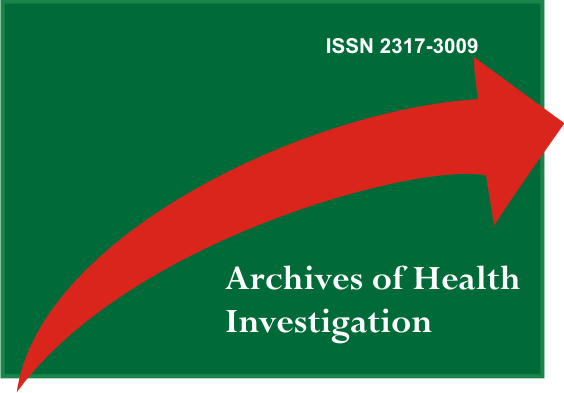Emprego dos cimentos resinosos autoadesivos: uma abordagem sobre a eficácia e os protocolos empregados
DOI:
https://doi.org/10.21270/archi.v7i9.3156Abstract
Com o avanço da Odontologia Adesiva, através da criação dos cimentos resinosos autoadesivos, ocorreu uma melhoria na interação química com os substratos e os procedimentos que necessitam de um material cimentante, os quais passaram a apresentar sensível melhora, tanto na técnica quanto na garantia de longevidade do procedimento restaurador/reabilitador. Entretanto, assim como os cimentos resinosos convencionais, os autoadesivos apresentam limitações, sendo, portanto, imprescindível o conhecimento das recomendações da literatura atual para uma correta utilização do material sem prejudicar seu desempenho. Este trabalho objetivou através de uma revisão de literatura coletar as informações mais atuais sobre os cimentos resinosos autoadesivos bem como elucidar possíveis limitações destes materiais. Para o esmalte as recomendações encontradas são de realização de condicionamento ácido seletivo. Para a dentina, como se trata de um substrato altamente orgânico, onde o condicionamento ácido pode remover a smear layere promover uma sensibilidade pós- operatória a aplicação do cimento apenas, parece ser a melhor indicação. Para substratos a base de ligas metálicas e a zircônia a criação de micro retenções ou a utilização de agentes de união química ainda é recomendável devido à fraca interação dos ácidos dos cimentos resinosos autoadesivos com estas superfícies.Descritores: Cimentos Dentários; Cimentos de Resina; Revisão.
Downloads
References
Manso AP, Carvalho RM. Dental cements for luting and bonding restorations self-adhesive resin cement. Dent Clin North Am. 2017; 61(4):821-34.
Vieria Filho WS, Alonso RCB, Gonzaléz AHM, D’alpino PHP, Di Hipólito V. Bond strength and chemical interaction of self-adhesive resin cements according to the dentin region. Int J Adhes Adhes. 2017; 73:22-7.
Zayetev D, Panfilov P. Anisotropy of the mechanical properties of human dental enamel. Mater Lett. 2015; 159:428-31.
Hattar S, Hatamleh M, Khraisat A, Al-Rabah M. Shear bond strength of self-adhesive resin cements to base metal alloy. J Prosthet Dent. 2014; 111(5):411-15.
Blatz MB, Mante FK, Saleh N, Atlas AM, Mannan S, Ozer F. Postoperative tooth sensitivity with a new self-adhesiveresin cement - a randomized clinical trial. Clin Oral Investig. 2013; 17(3):793-98.
Ferracane JL, Stansbury JW, Burke FJT. Self-adhesive resin cements – chemistry, propertiesand clinical considerations. J Oral Rehabil. 2011; 38(4):295-314.
Monticelli F, Osorio R, Mazzitelli C, Ferrari M, Toledano M. Limited decalcification/diffusion of self-adhesive cements into dentin. J Dent Res. 2008; 87(10):974-79.
Mazzitelli C, Monticelli F, Osorio R, Casucci A, Toledano M, Ferrari M. Effect of simulated pulpal pressure on self-adhesive cements bonding to dentin. Dental Mater. 2008; 24(9):1156-63.
De Souza FB, Delfino CS, Turbino NL, Braz R.
Deproteinized dentin: a favorable substrate to self-bonding resin cements? J Biomed Mater Res B Appl Biomater. 2011; 98(2):387-94.
Marghalani HY. Sorption and solubility characteristics of self-adhesive resincements. Dental Mater. 2012; 28(10):e187-98.
Kahnamouei MA, Mohamadi N, Navimipour EJ, Shakerifar M. Push-out bond strength of quartz fibre posts to root canal dentin using total-etchand self-adhesive resin cements. Med Oral Patol Oral Cir Bucal. 2012; 17(2):e337-44.
Zorzin J, Belli R, Wagner A, Petchelt A, Lohbauer U. Self-adhesive resin cements: adhesive performance to indirect restorative ceramics. J Adhes Dent. 2014; 16(6):541-46.
Youm SH. Jhung KH, Son SA, Kwon YH, Park JK. Effect of dentin pretreatment and curing mode on the microtensile bond strength of self-adhesive resin cements. J Adv Prosthodont. 2015; 7(4):317-22.
Silva Fonseca AS, Mizrahi J, Menezes LR, Valente LL, de Moraes RR, Schneider LF. The effect of time between handling and photoactivation on self-adhesive resin cement properties. J Prosthodont. 2014; 23(4):302-7.
Saker S, Alnazawi A, Ozean M. Adhesive strength of self-adhesive resins to lithium disilicateceramic and dentin: effect of dentin chelating agents. Odontology. 2016; 104(1):53-9.
Di Hipólito V, Rodrigues FP, Piveta FB, Azevedo LC, Alonso RCB, Silikas N et al. Effectiveness of self-adhesive luting cements in bonding tochlorhexidine-treated dentin, Dental Mater. 2012; 28(5):495-501.
Takimoto M, Ishii R, Iino M, Shimizu Y, Tsujimoto A, Takamizawa T et al. Influence of temporary cement contamination on thesurface free energy and dentine bond strength of self-adhesive cements. J Dent. 2012; 40(2):131-38.
Lee SE, Bae JH, Choi JW, Jeon YC, Jeong CM, Yoon MJ et al. Comparative shear-bond strength of six dental self-adhesive resin cements to zirconia. Materials (Basel). 2015; 8(6):3306-15.
Goracci C, Cury AH, Cantoro A, Papacchini F, Tay FR, Ferrari M. Microtensile bond strength and interfacial properties of self-etching and self-adhesive resin cements used to lute composite onlays under different seating forces. J Adhes Dent. 2006; 8(5):327-35.
Campos RE. Adaptação marginal e resistência à fratura de coroas totais executadas em diferentes sistemas [tese]. Arararaquara: Faculdade de Odontologia de Araraquara, UNESP; 2005.


